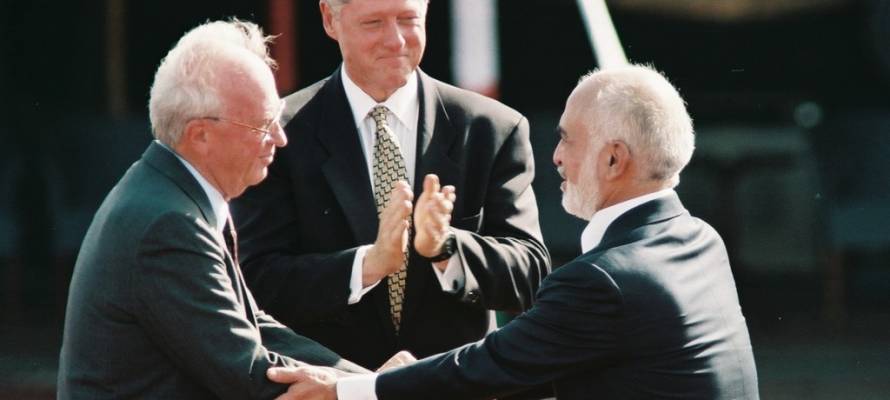This year marks a quarter century since Israel and Jordan signed their historic peace agreement.
By United with Israel Staff and AP
At an emotional ceremony on Oct. 26, 1994, attended by Israel’s then-prime minister, Yitzhak Rabin, Jordan’s late King Hussein and President Bill Clinton, Israel and Jordan signed a historic peace agreement that has stood the test of time, despite current challenges and bumps along the way.
“This is our gift to our peoples and the generations to come,” said Hussein at the time. “It will not be simply a piece of paper ratified by those responsible, blessed by the world. It will be real, as we open our hearts and minds to each other.”
Twenty-five years later, the peace agreement remains a vital strategic asset for both countries.
The deal has brought Israel much-needed quiet and a valuable partner along its longest border, while buttressing Jordan’s position as a crucial ally of the West in one of the world’s most volatile areas.
The two countries maintain close, covert security relations. Israel, a world leader in desalination, provides large quantities of water to Jordan, one of the driest countries on earth, and has agreed to sell natural gas to Jordan as well.
The warm relations envisioned at that signing ceremony remain elusive, however, with little public support for the agreement in Jordan, reflecting the prevailing anti-Israel sentiment in the Arab world.
Speaking at a Tel Aviv conference last month, Israel’s ambassador to Jordan, Amir Weissbrod, acknowledged that relations aren’t perfect, but he listed a long line of successes, including the water and energy cooperation, Jordan’s use of Israel’s Haifa port and an expanding program that allows hundreds of Jordanians to enter Israeli border towns to work.
Describing Jordan as a “strategic partner” and gateway to the broader Arab world, Weissbrod said: “We must try to make the utmost effort to ensure the stability and success of Jordan.”
Yet he also said there is more that Jordanian leaders could do, particularly in terms of building support among the Jordanian public.
“They can’t hide the degree of the relationship, and there are achievements to talk about,” he said.
Jordanian officials did not respond to a request for comment.
Painful History
Against this backdrop, Jordan last year announced that it was ending a special lease agreement under the 1994 treaty that returned two farming areas — Naharayim and Tzofar — to Jordanian sovereignty while allowing Israel continued use of the lands. Without Jordanian objections, the leases for the areas, would have automatically renewed.
Naharayim, located along the Jordan River in northern Israel, has become a popular tourist site. It includes a small park and picnic area, the ruins of a historic power station and the “Island of Peace,” where Israelis can briefly enter Jordanian territory without having to show their passports.
“We regard this place as part of a normalization and relationship with our neighbors from the other side of the border,” said Idan Grinbaum, head of the local regional council. He said he has sent a letter to Abdullah asking the king to reconsider but has not heard back.
The site has a painful history. In 1997, a Jordanian soldier opened fire at an Israeli crowd, killing seven schoolgirls on a class trip.
After the shooting, King Hussein traveled to Israel to ask forgiveness from the girls’ families. Twenty years after his death, Hussein remains a beloved figure in Israel for what was seen as a courageous act.
With the site set to revert to full Jordanian control in early November, Grinbaum said he still hopes that leaders can find a way to preserve Naharayim as a symbol of peace.
“We still think that joint projects can happen here for both countries, for the benefit of citizens in both countries,” he said. “Unfortunately, in reality things are not that simple.”
